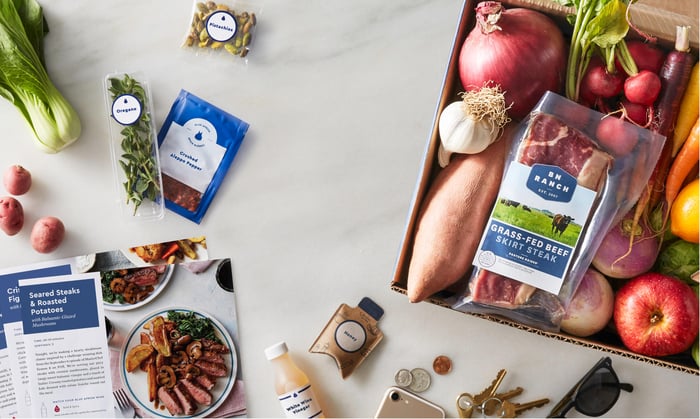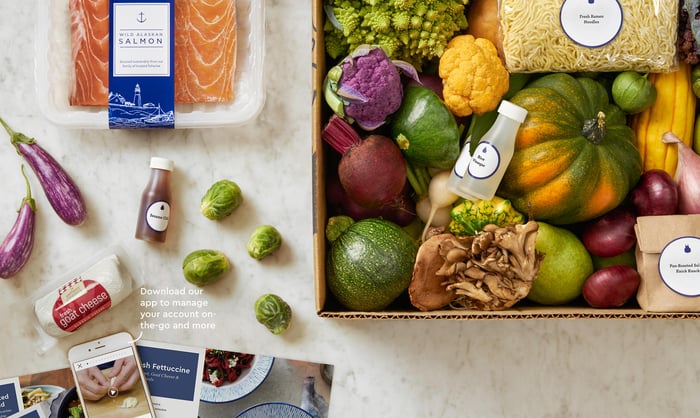Blue Apron's (APRN) 90% drop from its IPO price is a cautionary tale for businesses that can be easily replicated by bigger competitors. It initially enjoyed a first mover's advantage in the meal kit market, but rivals like HelloFresh, Kroger (KR 0.56%), and Amazon (AMZN -1.14%) quickly caught up and carved up the market.
Consumers also realized that meal kits were just overpriced boxes of groceries, and the prices were too high relative to pre-cooked, take out, or delivery options. Blue Apron desperately tried to stay relevant with new partnerships and products, but it continued to lose customers at an alarming rate.

Image source: Blue Apron.
However, flickers of hope appeared last month when the company hired Linda Findley Kozlowski, the former chief operating officer of Etsy (ETSY -0.22%), as its new CEO. Its recent first quarter earnings report also revealed a few improvements, although it continues to lose customers. Let's examine Blue Apron's first-quarter numbers and see if Kozlowski can salvage this sinking ship.
The key numbers
Blue Apron's total number of customers fell 30% annually (but just 1% sequentially) to 550,000 during the quarter. Its revenue fell 28% to $141.9 million, missing estimates by about $8 million. Both figures mark continuations of Blue Apron's prior woes:
|
YOY growth |
Q1 2018 |
Q2 2018 |
Q3 2018 |
Q4 2018 |
Q1 2019 |
|---|---|---|---|---|---|
|
Customers |
(24%) |
(24%) |
(25%) |
(25%) |
(30%) |
|
Revenue |
(20%) |
(25%) |
(28%) |
(25%) |
(28%) |
YOY = Year-over-year. Source: Blue Apron quarterly results.
However, Blue Apron's orders per customer, average order value, and average revenue per customer all showed signs of stabilization:
|
Metric |
Q1 2018 |
Q2 2018 |
Q3 2018 |
Q4 2018 |
Q1 2019 |
|---|---|---|---|---|---|
|
Orders per customer |
4.4 |
4.4 |
4.1 |
4.3 |
4.5 |
|
Order value (YOY) |
(1%) |
(3%) |
(2%) |
0% |
1% |
|
Revenue per customer (YOY) |
6% |
(0%) |
(5%) |
2% |
3% |
YOY = Year-over-year. Source: Blue Apron quarterly results.
During the conference call, CFO Tim Bensley called those figures "key indicators of a strengthening customer base," and stated that the company's loss of overall customers resulted from a "deliberate decision to prioritize a narrower set of high affinity consumers."
In other words, Blue Apron wants to offset its declines in its total customers by growing its revenue per remaining customer. Unfortunately, the anemic improvements in its orders per customer and order value still couldn't offset a 30% year-over-year reduction to its customer base.

Image source: Blue Apron.
Focusing on bottom line growth
Blue Apron also continued to focus on bottom line growth by reducing its operating expenses 36% annually. Within that total, it slashed its marketing expenses by 64%. I previously argued that Blue Apron's focus on cutting its marketing expenses would leave it more vulnerable to its rivals, but it remains stubbornly dedicated to this strategy.
Nonetheless, Blue Apron's cost-cutting initiatives enabled it to post a net loss of just $5.3 million for the first quarter, compared to a loss of $31.7 million a year earlier. Its loss of $0.03 per share topped expectations by four cents. Its adjusted EBITDA of $8.6 million also marked a significant improvement from its loss of $17.2 million a year ago.
Kozlowski doesn't seem interested in shifting Blue Apron's focus from profitability toward aggressive growth. During the conference call, she called Blue Apron's achievement of positive free cash flow and adjusted EBITDA profitability "critical milestones" for the company.
Blue Apron didn't provide any revenue guidance for the second quarter, but it forecasts a net loss of $13 to $16 million, with an adjusted EBITDA of $0 to $3 million. It blames that sequential decline on "typical seasonal trends heading into the summer months."
Vague turnaround plans
Kozlowski's turnaround plans remain vague. She supports the company's prior focus on the "highest affinity customers" instead of going toe-to-toe against bigger rivals like Amazon or Kroger, and claims that a focus on a "differentiated customer-centric strategy" will help it reach "untapped, attractive growth prospects" over the long term.
But it's unclear what those prospects actually are, and Kozlowski stated that the company will reveal its "growth strategy in the coming weeks and months." Meanwhile, Bensley reiterated that the company will continue its strategy of "deliberately not pursuing unproductive revenue" and focus on its growth in average orders and revenue per customer.
No turnaround in sight yet
Blue Apron's focus on growing its orders and revenue makes sense, but its expectation for that anemic growth to offset its ongoing customer losses is dangerous. Blue Apron wants investors to believe that its losses will bottom out as it rightsizes its business, but I wouldn't buy this stock until it stops losing customers, at least on a sequential basis.





